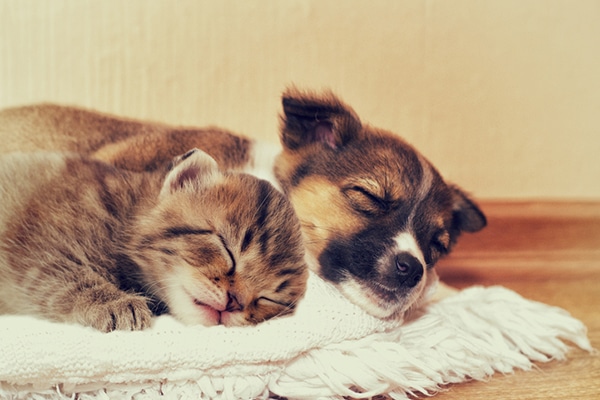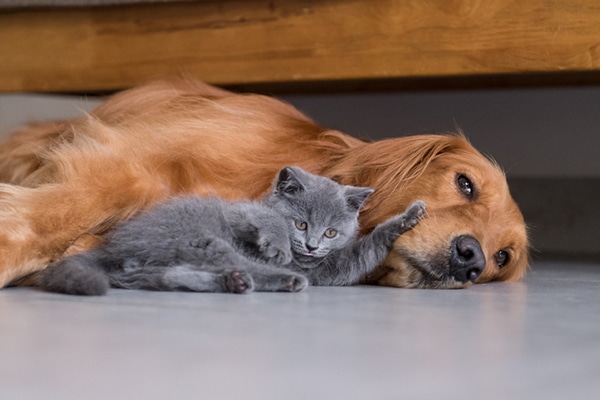We all know cats who act like dogs, right? You know, that cat — he’s very vocal, follows you around closer than a shadow, actually likes walking on a leash and even fetches. Cats who think they’re dogs are definitely originals. So, let’s take a peek at what makes these dog-like cats such unique gems.
What cat breeds act like dogs?

While any cat might harbor an inner dog, these seven cat breeds are much more likely to channel their inner canines:
- The gorgeous all-white Turkish Angora cat is one of the most dog-like cat breeds. These in-your-face cats like to be the center of your world. They’re playful, devoted, sociable and love to welcome your guests. Turkish Angora cats are at home in the water and might just swim laps around you. Keep these canine wannabes happy and healthy with daily play time.
- The Manx breed connects to her human family like no other cat. She’s a travel bug and loves nothing more than calling shotgun and accompanying you on errands. The Manx is an excellent walking partner and will help keep you both fit and healthy. The caveat — overprotective Manx cats don’t always like strangers entering their house and will say so with their best dog-like roars.
- Meet the Abyssinian — this amazing cathlete is an energetic, on-the-go companion. Abys are also playful and easily leash trained.
- The Maine Coon is one of the largest cat breeds, a.k.a. a small dog in a cat suit. “Maine Coons are the retrievers of the cat world,” says Dr. Sarah Miller, a veterinarian and mama to two of these gorgeous gentle giants. “They enjoy chasing toys and will bring them back to you.”
- A cuddly lap cat, the Ragdoll is most comfortable snug up against his humans. If you’re on the move, your Ragdoll is moving alongside you throughout the house.
- Close relatives, the Burmese and the Siamese breeds are some of the most vocal and expressive felines.
What behaviors do cats and dogs have in common?
Cats and dogs are two of the most popular pets worldwide because they share the innate desire and ability to form strong bonds with their human families.
They both communicate through body language — facial expressions, ear and tail positions, tail activity and overall body position, such as a cat’s arching back, show us and other furry friends or foes how they feel and what they need.
Cat and dogs also use their strong senses of smell to acquaint themselves with other animals and to make sense of hormonal clues left behind. Both species swivel their multi-muscled ears to tune into far off sounds. Dogs and cats circle their beds before curling up for a nap, a behavior carried over from the wild.
What cat and dog behaviors are totally different?

Certain behaviors are distinctly either cat or dog.
The most obvious difference is in response to housetraining — we’re talking peeing and pooping here! Cats get it almost immediately. Dogs, unfortunately, take their doggone time and may take months to get it right.
Cats are natural jumpers and crave heights, while most dogs prefer to keep their paws on the ground. Dogs tend to only jump as high as that prime spot on the couch, that oh-so-comfortable bed or that guest who just walked through the door.
Dogs are pack animals, and most pups thrive in a family atmosphere. For cats, the preference for sociability versus solitude is unique to each cat — some enjoy playing and interacting with feline siblings and friends, while others are happiest alone and may never accept another kitty pal.
Mealtime behaviors also separate cats from dogs. Dogs are comfortable eating whether they’re eating solo or alongside their doggie siblings. Cats prefer to eat alone.
Can you train your cat to act like a dog?
Absolutely!
Cats are intelligent and malleable animals — with patience, you can teach your cat to perform tricks, fetch a toy, come when you call his name and more. Cats will quickly learn to associate a specific behavior with the sound of a clicker.
Karen Pryor, behavioral biologist and founder of Karen Pryor Academy of Animal Training and Behavior and clicker training proponent says, “For today’s city cats, often living out their entire lives confined indoors, clicker training can provide valuable mental and physical stimulation; it enriches the cat’s life and can help the cat to be healthier, happier and a more responsive companion.”
Skeptical? Look at these Amazing Acro-cats!
Still don’t believe there are cats like dogs out there?
The proof is in these videos! These silly dog-like cats will have you laughing out loud with their canine-esque antics:
This Ragdoll cat thinks he’s a dog. Follow his adventures on his Facebook page at Timo the Ragdoll Cat.
And here are eight signs that your cat might actually be a dog:
Thumbnail: Photography ©chendongshan | Thinkstock.
Read more about cat behaviors on Catster.com:








